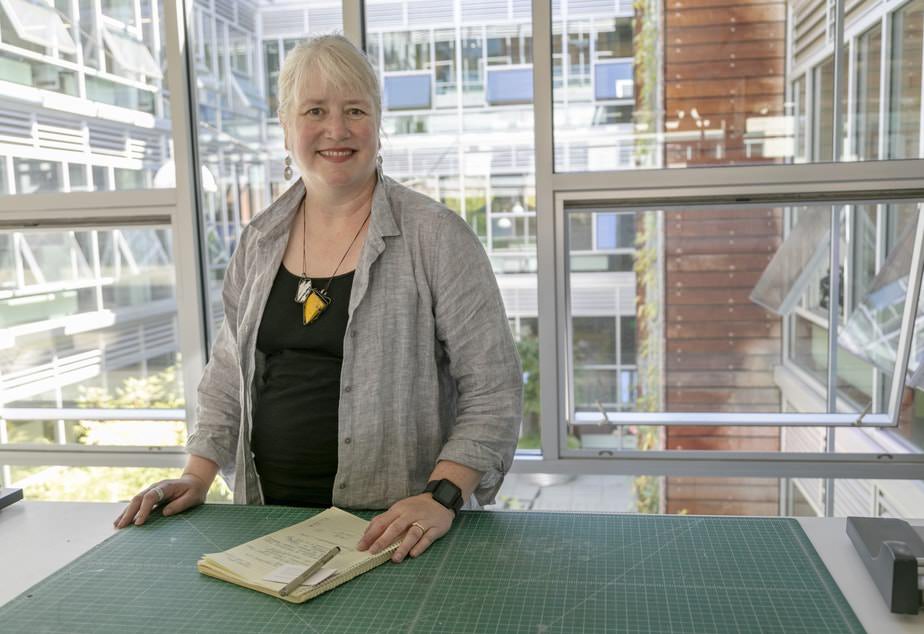The content for this article was originally featured on NPR KUOW on July 27, 2018.

Kristen Scott, partner at Weber Thompson, stands in front of the courtyard/thermal chimney that draws a breeze across her office in lieu of air conditioning (Photo courtesy of KUOW)
It’s hot outside. In most offices in Seattle, air conditioning keeps the employees cool. That’s not happening at the architecture firm Weber Thompson.
Ten years ago, they built their new headquarters in Seattle’s South Lake Union neighborhood — without air conditioning, to prove it could be done.
We went to their office to see how they’re surviving the heat.
It’s 85 degrees outside the Terry Thomas building; inside it’s 78 degrees. Kristen Scott, a partner at Weber Thompson, is sweating slightly.
“I did have to walk briskly from a lunch three quarters of a mile away to get here in time for this, so that’s really why I’ve got ‘the glow’ going,” she explained.
Scott’s fine with talking about her “glow,” because she believes air conditioning tends to cut you off from the outside world.
“You forget how hardwired humans are to really enjoy the natural environment,” she said. People get respite from being connected to nature, she said, “even in an urban environment like a city. Those opportunities become really precious.”
Connecting with nature means making some compromises. For example, this office has a casual dress code. People here wear shorts and flip flops.
Then there’s the office hours: During heat waves like this one, people are encouraged to shift their hours, coming in early and leaving early to beat the peak temperatures, which arrive around 4:30 or 5:00 pm.
These adjustments mean cost savings. The office building uses about half the electricity of a more traditional office.
But you can’t just take a regular modern office and remove the AC. This building was designed to stay naturally cool from its very inception.
The office is shaped like a donut, with a courtyard at the center, lined with windows you can open. The perimeter of the building also has operable windows.
When you open up the windows on both sides, the courtyard becomes what’s called a thermal chimney. It sucks up air and pushes it into the sky. That draws a breeze across the office. It all happens naturally, without power.
“So when people ask what is it like inside this building without air conditioning on a hot day, it’s really like being under the shade of a big tree outside and you’ve got this gentle breeze washing over you,” said Scott. “It’s warm, but it’s comfortable because there’s air movement.”
Everything in the building’s interior, from low cubicle walls to structural beams pierced with ventilation holes, are designed not to impede the flow of air. Overnight, this breeze continually flushes the remaining heat out of the building so it’s freshly chilled for employees the next morning.
The four-story building was built to show off these techniques.
The workers at Weber Thompson are totally into it. But selling it to others has not been easy.
“I guess I have to say that we have not succeeded in having another project without air conditioning,” Scott said. “That’s mainly I think because while we’re really focused on sustainable design, and the new projects are also, they’re larger buildings.”
Meaning, the office spaces are wider, which makes it harder to draw breezes across them.
Also, this system doesn’t work without the central courtyard. Most developers aren’t interested or able to leave a chunk of un-rentable space in the middle of their building.
Climate change may be another factor. When the firm ran temperature simulations before the office was built, they estimated the office would be truly too hot for human comfort about 20 hours a year. Now, that’s climbed to around 30 hours a year.
One day last year, the outside temperature reached almost 100 degrees.
The firm setup a kiddie pool in the courtyard and everybody got a popsicle.
When KUOW first covered this building in 2009, we explored the history of “alphabet” shaped buildings with thermal chimneys. You can see the slideshow of alphabet buildings on flickr.
Listen to the interview with KUOW